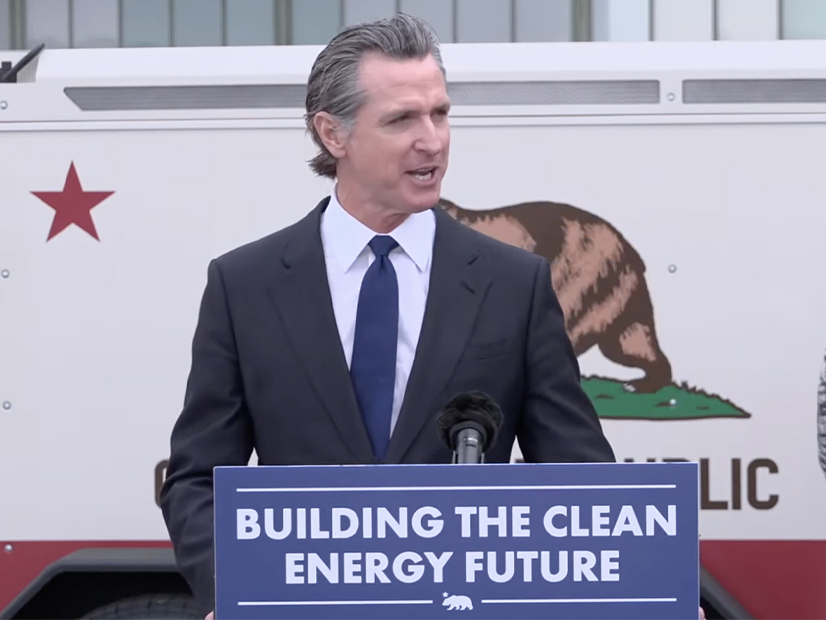
California Gov. Gavin Newsom on Thursday released a clean energy transition plan that’s long on ambition and congratulatory notes about the state’s progress in meeting its renewable energy targets but short on specifics about how it will hit its aggressive decarbonization goals leading up to 2045.
Instead, the plan appears to be the opening salvo in a campaign to motivate California lawmakers to support Newsom’s legislative package to streamline the permitting of clean energy projects across the state, including transmission lines, generating resources and factories to build clean technologies. (See Calif. Governor, PUC Take Steps to Speed Project Development.)
“The process-laden world we invented is now competing against us. We have to accelerate our transition,” Newsom said in announcing the plan Thursday at an event at Moxion Power’s first factory in the industrial city of Richmond. Founded in 2019, the company manufactures mobile batteries designed to replace diesel generators.
The plan’s lengthy executive summary lauds California for a number of policy-related accomplishments, including generating 37.2% of its electricity from renewables in 2021, reaching 5,000 MW of battery storage capacity this spring and having zero-emission vehicles claim 21% of the state’s automobile market.
It also outlines the state’s three main challenges in implementing its energy transition: planning for high electrification, deploying clean energy resources and ensuring electric grid reliability during extreme events.
And buried within that outline is what looks to be Newsom’s most concrete concern.
“Realizing California’s clean electricity goals reliably, affordably and equitably requires an unprecedented scale of new clean, diverse electric resources to match electricity demand growth,” the plan says. “This acceleration requires rethinking and updating permitting, procurement and project development processes to bring clean energy infrastructure online quickly.”
The Agenda
Newsom’s legislative proposals are contained in “trailer bills,” so-called because they follow the governor’s proposed budget for fiscal year 2023/24, which he issued in January and revised in May. Newsom must find lawmakers willing to introduce these bills.
One bill would establish a central procurement authority to ensure the state has sufficient electricity resources to avoid shortfalls as it struggles with extreme heat, tight supply and a changing resource mix across the West.
The governor’s proposal would give the California Public Utilities Commission the option to name the Department of Water Resources or an investor-owned utility to procure energy for the state’s load-serving entities, including public utilities and community choice aggregators. (See Calif. Governor Seeks Central Procurement Authority.)
Another would streamline judicial review of certain clean-energy and transportation projects by requiring that challenges to the projects under the California Environmental Quality Act be resolved within 270 days, including lawsuits and appeals. A related measure would streamline procedures for the preparation of the public record for court review of CEQA challenges.
Newsom has also proposed a bill that would allow but mitigate the removal of western Joshua trees, iconic California desert plants the state Fish and Game Commission is considering listing under the California Endangered Species Act but that occupy land slated for utility-scale solar arrays.
“The western Joshua tree occurs across a large portion of California’s desert region where renewable energy and housing development are essential for the state,” the proposed bill says. “Due to the widespread distribution of the western Joshua tree across the California desert region … there is a critical need to immediately conserve the species while also ensuring timely and efficient permitting mechanisms for activities within its range. Making a transition to a carbon-free energy future and providing housing for Californians are among the highest of state priorities.”
Newsom’s trailer bills also include one to repeal state statutes that designate 37 “fully protected” animal, fish and bird species.
“The bill would reclassify the 37 fully protected species so that 15 will be listed as threatened under the California Endangered Species Act, 19 will be listed as endangered under CESA, and three will have no listing status and would retain the protections afforded to species generally under the Fish and Game Code,” a fact sheet on the bill says.
Those remaining in the threatened category would include wolverines and sandhill cranes. California condors and bighorn sheep would remain listed as endangered, with 17 others. Those remaining unlisted would include peregrine falcons and brown pelicans.
On Thursday, the State Senate budget subcommittee on resources, environmental protection and energy was scheduled to discuss the proposals as part of the budget process, which can lead to quicker approval and avoid measures getting held up in policy committees.
But the subcommittee’s staff recommended that the bills, if they find sponsors, should be heard in policy committees, such as the Energy, Utilities and Communications Committee and the Natural Resources and Water Committee.
“The 10 trailer bill proposals above were provided to the Legislature and the public on May 19, 2023,” staff wrote. “Because of the complexity of these issues and limited time to deliberate, it would be reasonable and prudent for these proposals to [be] reviewed through the policy process.”
‘Running Against Time’
At Thursday’s event, Newson laid out the need for permitting changes in strong — if extreme — terms, as the world faces the growing strains of climate change.
“We need to build; we need to get things done,” he said. “This is not an ideological exercise. We’re running against time. Mother Nature bats last; she bats a thousand. She’s chemistry; she’s biology; she’s physics. She doesn’t mess around. We don’t have time to hold hands and talk about the way the world should be. We’ve got to go.”
Newsom also suggested that inaction on permitting represented a test for democratic government.
“If we don’t build, democracy is questioned [based on] our capacity to deliver,” he said. “Why do you think so many of these authoritarians are asserting themselves in their might [and] muscle, not just around the world, but in some other parts of this country? It’s because they say we can’t get things done anymore.”